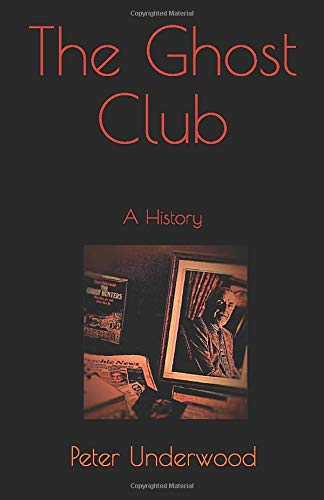
Reviewed by Tom Ruffles
Anyone expecting to read an account of precisely what led Peter Underwood to resign his life presidency of the Ghost Club, or to enjoy watching him settle old scores (if any exist), will be disappointed. This brief account of the Ghost Club – or Clubs, as it has gone through a number of separate manifestations during its existence, each one generally having a tenuous connection to its predecessor – has little to say about the split that led to the formation of the Ghost Club Society, but rather concentrates on Underwood’s presidency of the Ghost Club, a reign which lasted over thirty years.
The history begins with the obscure origins of the Ghost Society (or Cambridge Ghost Club) in 1851, and the formation of the Ghost Club in 1862. It is unlikely that Edmund Gurney (b 1847) or Arthur Balfour (b 1848) were members of the original 1851 society, as Underwood claims. That the 1862 version attracted attention is indicated, as Underwood notes, by George Cruikshank’s dedication to the Ghost Club of his book A Discovery Concerning Ghosts, published the following year, though Underwood doesn’t add that Cruikshank was probably being sarcastic. More space is devoted to the 1882-1936 incarnation as the records have survived, but perhaps the section on its members and activities could have been expanded further.
More too could surely have been said about the Harry Price years (1938-47). One gets the feeling that Underwood’s interest in the earlier days is slight compared to when the Club was under his own guidance. His main focus is what he terms the “third revival“, the period from 1954-93. Underwood became president in 1960, and ran the organisation with huge energy, attracting a large number of celebrity supporters, the sort of thing the SPR was good at in its early days. I have to declare an interest here as I applied to join the invitation-only organisation (as it was before the organisation relaxed its rules following Underwood’s departure), and was rejected. I can see I missed some tremendous meetings addressed by a who’s who of the paranormal world.
This is actually a revised, expanded and much more professionally produced version of a booklet Underwood produced in 2000, under the slightly different title “The Ghost Club Society – A History” (White House Publications; the cover carries the title “A Short History of the Ghost Club Society”). The change of title is significant because Peter Underwood resigned the life presidency of the Ghost Club in 1993 and became life president of the new Ghost Club Society, which he formed the same year. The original title was misleading as the booklet was about the history of the Ghost Club up to 1993, not the new Ghost Club Society. For this version the word ‘Society’ has been omitted from the title, which makes it more accurate, as it is still a history of the Ghost Club ending in 1993. The new title allows Underwood to avoid the anomalous situation of describing individuals as members of the Ghost Club Society before it was actually formed, which he had in the first edition. Unfortunately Underwood’s website still proclaims (or at least does at the time of writing) that he is “Life President, Ghost Club Society (founded 1851)”, which of course it wasn‘t.
The ending of the new booklet is substantially different to that in the old one. In the original edition, Underwood merely says that “1993 saw the emergence of the present ‘GHOST CLUB SOCIETY’ with myself as Life President,” with no indication why the Society was formed and implying a straightforward transition from one organisation to another. The new edition does now acknowledge that the Ghost Club continued in parallel, and Underwood says that he resigned as its president after receiving negative comments, though he did not leave the Club itself. The Ghost Club Society was obviously formed in competition, but Underwood gives a misleading impression when he says that “For a while both clubs staggered along”, which suggests that neither now exists.
The Ghost Club Society does appear to be defunct (as long ago as 2005, according to Rosemary Ellen Guiley’s The Encyclopedia of Ghosts and Spirits, third edition, 2007; she also gives more of the background to the efforts to revive the Club after Harry Price’s death, which Underwood leaves out). The Ghost Club on the other hand continues to thrive, with a full programme of activities. It is also surely incorrect to refer to the “third revival” as occurring between 1954 and 1993”, as if the Ghost Club changed character at that point. The Club retained its character after Underwood left, and is still the same organisation that was reconstituted in 1954, apart from being easier to join these days. The entry for the Ghost Club should read “1954 to date”.
Throughout their respective histories there has been an overlap in the membership of the Ghost Club and the Society for Psychical Research. The SPR is featured a number of times, but whereas many potted histories focus on the Cambridge connection and omit the role played by William Barrett and Edmund Dawson Rogers in its formation, Underwood goes the other way and excludes Sidgwick, Myers and Gurney from its foundation altogether, implying that the SPR began solely as a Spiritualist organisation.
The booklet is only 43 pages, which seems rather perfunctory for a history stretching back nearly 160 years, even if information about the early period is in short supply. The poor-quality illustrations of the first edition have been replaced with much better quality ones mostly taken from the author’s collection, and there is an excellent index. This brief survey will be of use to anyone interested in the history of the several associations that have been called “The Ghost Club”, but the definitive account, including the Club’s evolution since 1993, when Underwood left in a huff, remains to be written.

